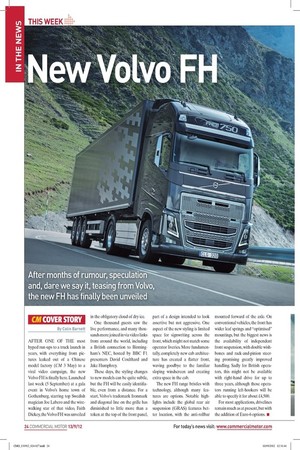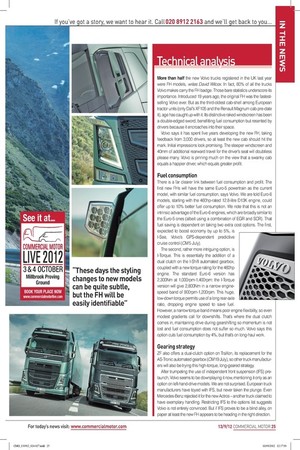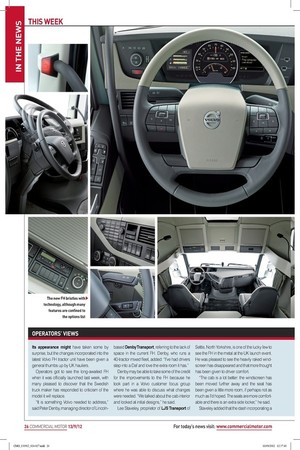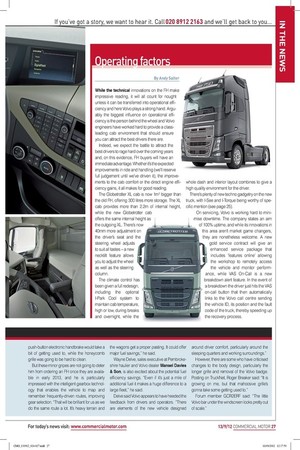New Volvo FH
Page 12

Page 13

Page 14

Page 15

If you've noticed an error in this article please click here to report it so we can fix it.
After months of rumour, speculation and, dare we say it, teasing from Volvo, the new FH has finally been unveiled
By Colin Barnett
AFTER ONE OF THE most hyped run-ups to a truck launch in years, with everything from pictures leaked out of a Chinese model factory (CM 3 May) to a viral video campaign, the new Volvo FH is inally here. Launched last week (5 September) at a gala event in Volvo’s home town of Gothenburg, starring top Swedish magician Joe Labero and the wirewalking star of that video, Faith Dickey, the Volvo FH was unveiled
in the obligatory cloud of dry ice.
One thousand guests saw the live performance, and many thousands more joined in via video links from around the world, including a British connection to Birmingham’s NEC, hosted by BBC F1 presenters David Coulthard and Jake Humphrey.
These days, the styling changes to new models can be quite subtle, but the FH will be easily identiiable, even from a distance. For a start, Volvo’s trademark Ironmark and diagonal line on the grille has diminished to little more than a token at the top of the front panel, part of a design intended to look assertive but not aggressive. One aspect of the new styling is limited space for signwriting across the front, which might not match some operator liveries. More fundamentally, completely new cab architecture has created a latter front, waving goodbye to the familiar sloping windscreen and creating extra space in the cab.
The new FH range bristles with technology, although many features are options. Notable highlights include the global rear air suspension (GRAS) features better location, with the anti-rollbar mounted forward of the axle. On conventional vehicles, the front has wider leaf springs and “optimised” mountings, but the biggest news is the availability of independent front suspension, with double wishbones and rack-and-pinion steering promising greatly improved handling. Sadly for British operators, this might not be available with right-hand drive for up to three years, although those operators running left-hookers will be able to specify it for about £4,500.
For most applications, drivelines remain much as at present, but with the addition of Euro-6 options. ■
TechnicaL anaLysis
More than half the new Volvo trucks registered in the UK last year were FH models, writes David Wilcox. In fact, 60% of all the trucks Volvo makes carry the FH badge. Those bare statistics underscore its importance. Introduced 19 years ago, the original FH was the fastestselling Volvo ever. But as the third-oldest cab-shell among European tractor units (only Daf’s XF105 and the Renault Magnum cab pre-date it), age has caught up with it. Its distinctive raked windscreen has been a double-edged sword, benefitting fuel consumption but resented by drivers because it encroaches into their space.
Volvo says it has spent five years developing the new FH, taking feedback from 3,000 drivers, so at least the new cab should hit the mark. Initial impressions look promising. The steeper windscreen and 40mm of additional rearward travel for the driver’s seat will doubtless please many. Volvo is pinning much on the view that a swanky cab equals a happier driver, which equals greater profit.
Fuel consumption
There is a far clearer link between fuel consumption and profit. The first new FHs will have the same Euro-5 powertrain as the current model, with similar fuel consumption, says Volvo. We are told Euro-6 models, starting with the 460hp-rated 12.8-litre D13K engine, could offer up to 10% better fuel consumption. We note that this is not an intrinsic advantage of the Euro-6 engines, which are broadly similar to the Euro-5 ones (albeit using a combination of EGR and SCR). That fuel saving is dependent on taking two extra cost options. The first, expected to boost economy by up to 5%, is I-See, Volvo’s GPS-dependent predictive cruise control (CM 5 July).
The second, rather more intriguing option, is I-Torque. This is essentially the addition of a dual clutch on the I-Shift automated gearbox, coupled with a new torque rating for the 460hp engine. The standard Euro-6 version has 2,300Nm at 1,000rpm-1,400rpm: the I-Torque version will give 2,800Nm in a narrow enginespeed band of 900rpm-1,200rpm. This huge, low-down torque permits use of a long rear-axle ratio, dropping engine speed to save fuel. However, a narrow torque band means poor engine flexibility, so even modest gradients call for downshifts. That’s where the dual clutch comes in, maintaining drive during gearshifting so momentum is not lost and fuel consumption does not suffer so much. Volvo says this option cuts fuel consumption by 4%, but that’s on long-haul work.
Gearing strategy
ZF also offers a dual-clutch option on TraXon, its replacement for the AS-Tronic automated gearbox (CM 19 July), so other truck manufacturers will also be trying this high-torque, long-geared strategy.
After trumpeting the use of independent front suspension (IFS) prelaunch, Volvo seems to be downplaying it now, mentioning it only as an option on left-hand-drive models. We are not surprised. European truck manufacturers have toyed with IFS, but never taken the plunge. Even Mercedes-Benz rejected it for the new Actros – another truck claimed to have exemplary handling. Restricting IFS to the options list suggests Volvo is not entirely convinced. But if IFS proves to be a blind alley, on paper at least the new FH appears to be heading in the right direction.
OPERATORS’ VIEWS
Its appearance might have taken some by surprise, but the changes incorporated into the latest Volvo FH tractor unit have been given a general thumbs up by UK hauliers.
Operators got to see the long-awaited FH when it was officially launched last week, with many pleased to discover that the Swedish truck maker has responded to criticism of the model it will replace.
“It is something Volvo needed to address,” said Peter Denby, managing director of Lincoln
based Denby Transport, referring to the lack of space in the current FH. Denby, who runs a 40-tractor mixed fleet, added: “I’ve had drivers step into a Daf and love the extra room it has.”
Denby may be able to take some of the credit for the improvements to the FH because he took part in a Volvo customer focus group where he was able to discuss what changes were needed. “We talked about the cab interior and looked at initial designs,” he said.
Lee Staveley, proprietor of LJS Transport of Settle, North Yorkshire, is one of the lucky few to see the FH in the metal at the UK launch event. He was pleased to see the heavily raked windscreen has disappeared and that more thought has been given to driver comfort.
“The cab is a lot better: the windscreen has been moved further away and the seat has been given a little more room, if perhaps not as much as I’d hoped. The seats are more comfortable and there is an extra side locker,” he said.
Staveley added that the dash incorporating a push-button electronic handbrake would take a bit of getting used to, while the honeycomb grille was going to be hard to clean.
But these minor gripes are not going to deter him from ordering an FH once they are available in early 2013, and he is particularly impressed with the intelligent gearbox technology that enables the vehicle to map and remember frequently-driven routes, improving gear selection. “That will be brilliant for us as we do the same route a lot. It’s heavy terrain and the wagons get a proper pasting. It could offer major fuel savings,” he said.
Wayne Delve, sales executive at Pembrokeshire haulier and Volvo dealer Mansel Davies & Son, is also excited about the potential fuel efficiency savings. “Even if it’s just a mile of additional fuel it makes a huge difference to a large fleet,” he said.
Delve said Volvo appears to have heeded the feedback from drivers and operators. “There are elements of the new vehicle designed around driver comfort, particularly around the sleeping quarters and working surroundings.” However, there are some who have criticised changes to the body design, particularly the longer grille and removal of the Volvo badge. Posting on TruckNet, Roger Breaker said: “It is growing on me, but that mahoosive grille’s gonna take some getting used to.” Forum member GCR2ERF said: “The little Volvo bar under the windscreen looks pretty out of scale.”
Operating factors
By Andy Salter While the technical innovations on the FH make impressive reading, it will all count for nought unless it can be transferred into operational efficiency and here Volvo plays a strong hand. Arguably the biggest influence on operational efficiency is the person behind the wheel and Volvo engineers have worked hard to provide a classleading cab environment that should ensure you can attract the best drivers there are.
Indeed, we expect the battle to attract the best drivers to rage hard over the coming years and, on this evidence, FH buyers will have an immediate advantage. Whether it’s the expected improvements in ride and handling (we’ll reserve full judgement until we’ve driven it), the improvements to the cab comfort or the direct engine efficiency gains, it all makes for good reading.
The Globetrotter XL cab is now 1m3 bigger than the old FH, offering 300 litres more storage. The XL cab provides more than 2.2m of internal height, while the new Globetrotter cab
offers the same internal height as the outgoing XL. There’s now 40mm more adjustment on the driver’s seat and the steering wheel adjusts to suit all tastes – a new necktilt feature allows you to adjust the wheel as well as the steering column.
The climate control has been given a full redesign, including the optional I-Park Cool system to maintain cab temperature, high or low, during breaks and overnight, while the whole dash and interior layout combines to give a high quality environment for the driver.
There’s plenty of new techno gadgetry on the new truck, with I-See and I-Torque being worthy of specific mention (see page 25).
On servicing, Volvo is working hard to minimise downtime. The company states an aim of 100% uptime, and while its innovations in this area aren’t market game changers, they are nonetheless welcome. A new gold service contract will give an enhanced service package that includes ‘features online’ allowing the workshop to remotely access the vehicle and monitor performance, while VAS On-Call is a new breakdown alert feature. In the event of a breakdown the driver just hits the VAS on-call button that then automatically links to the Volvo call centre sending the vehicle ID, its position and the fault code of the truck, thereby speeding up the recovery process.




































